Why did you quit your last job? This was the main question in my recent study I did with designers. I received 156 responses to my survey, most of them were from Product/UX designers, second and third in number of responses were graphic designers, and web designers. Let’s dive into the results!
My new online course UX Buddy helps designers create their UX portfolio, find, and get an awesome UX design job. It’s now live and enrolment is open for a couple more days. Check it out!
53 percent of designers who responded to my survey were UX/Product Designers, around 17 percent were graphic, 9 percent web designers, 6 percent design generalists, 6 percent UI and visual designers, and around 4 percent were design managers. I have to admit that I’m surprised by these numbers as I didn’t expect such a large chunk of UX and Product designers. The “Product designer” title seems to have gained in popularity in the last couple of years so it would actually be interesting to see the breakdown of this largest group. I’ll separate the two the next time I run this study. A quick note about the study—respondents had to answer three questions:
- Why did you quit your last job?
- What kind of designer are you?
- What was your seniority at the time you left?
Participants could only pick one answer from a range of options. I know, even from my own experience, that there are usually multiple reasons why designers quit a job. But I decided to design the survey like that because I wanted to learn about the most pressing reason.
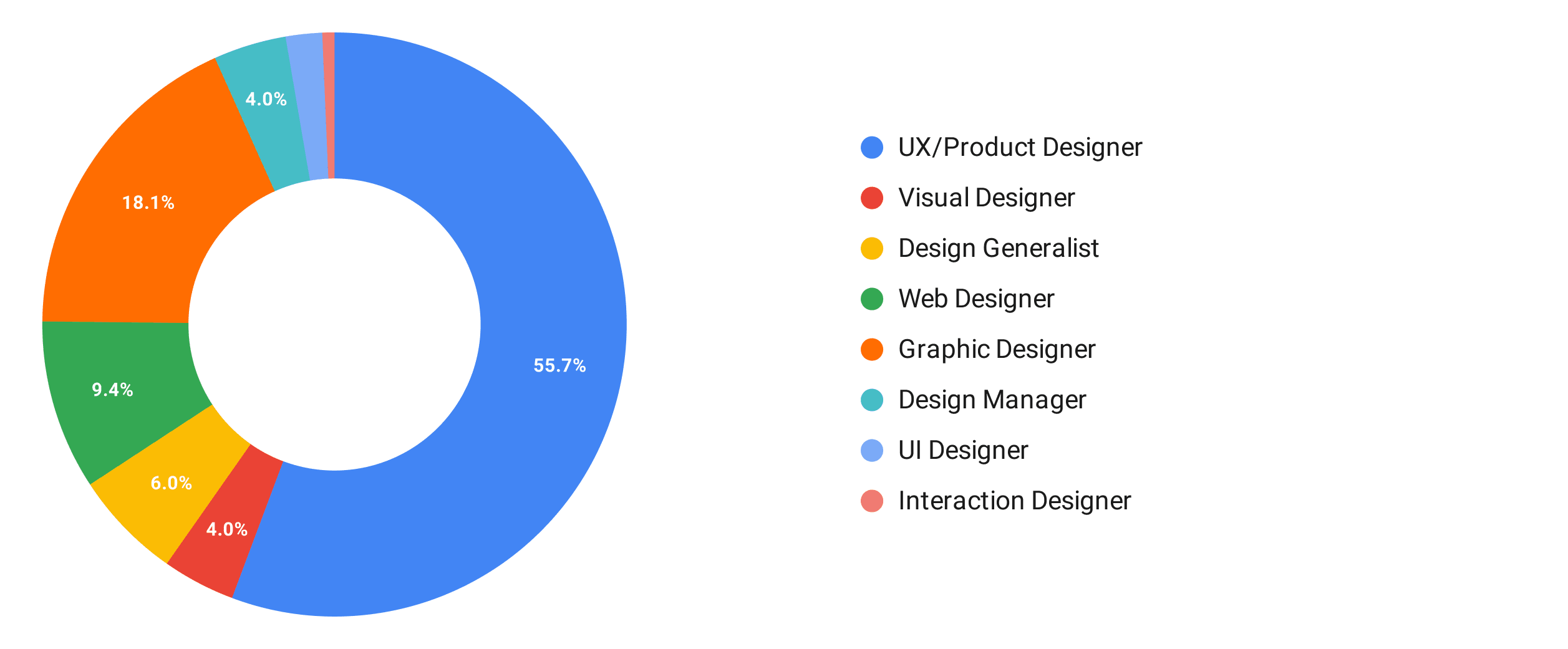
The UI and Visual Designers seem to be in decline as only around 6 percent identified themselves as such. I remember how this title was a lot more popular just a few years ago. I think that this two pieces of information—the rise in usage of the “Product designer” title, and the decline of UI and Visual Designers may be indicating that the role of UX Designers is evolving. The range of skills that they need to have is expanding beyond merely coming up with solutions to usability problems. Now they need to have visual design and UI design skills too. Something that I’m also noticing, especially with Product Designers, is the move to being more business-focused. So not just solving problems for users, but also solving business problems for the companies they work for. It’s not just a question of “how do we make this usable?” it’s more about “how do we make this usable for users and increase feature adoption which will drive more revenue?“ This is a trend that goes in the right direction because designers are problem solvers. It’s a waste to only use them for one side of problems.
I also believe that the 6 percent of Design Generalists indicates the rise of popularity of this role. We heard this title mentioned for the first time just a couple of years ago, now there’s already a significant number of people out there who consider themselves design generalists. We’re witnessing a consolidation of roles. The number of UX and Product designers, as well as Design Generalists will keep increasing in the next few years and we’ll continue to see the decline of more specialist roles like UI and Visual designers. A great example of this is the Interaction Designer role which was quite prominent just a few years ago but has now almost disappeared—less than one percent of participants picked this role.
An interesting question comes to mind—do these numbers indicate that the UX industry as a whole is reaching a more mature stage? A stage with a more equal distribution of a wider range of skills, lots of highly qualified designers who can perform most of these skills and then a smaller group of specialists alongside? I believe this could help mature the UX industry even more because more designers who can perform a wider range of skills will help elevate the quality of design work overall.
Seniority distribution
The breakdown by seniority is interesting. The largest chunk is Intermediate with 33 percent, followed by Senior at 28 percent, and finally Junior at 12 percent. The Intermediate part isn’t surprising, the ratio between Junior and Senior is. If we consider the Intermediate as the middle of the distribution, it makes sense that it gets the largest part. But there’s almost an equally sized part of senior designers out there, and a much smaller percentage of junior designers. Is this another sign that indicates the maturing of the UX industry? This is the very first time that I run this study but I’m sure that if I ran it 10 years ago, the percentage of junior designers would be significantly larger.
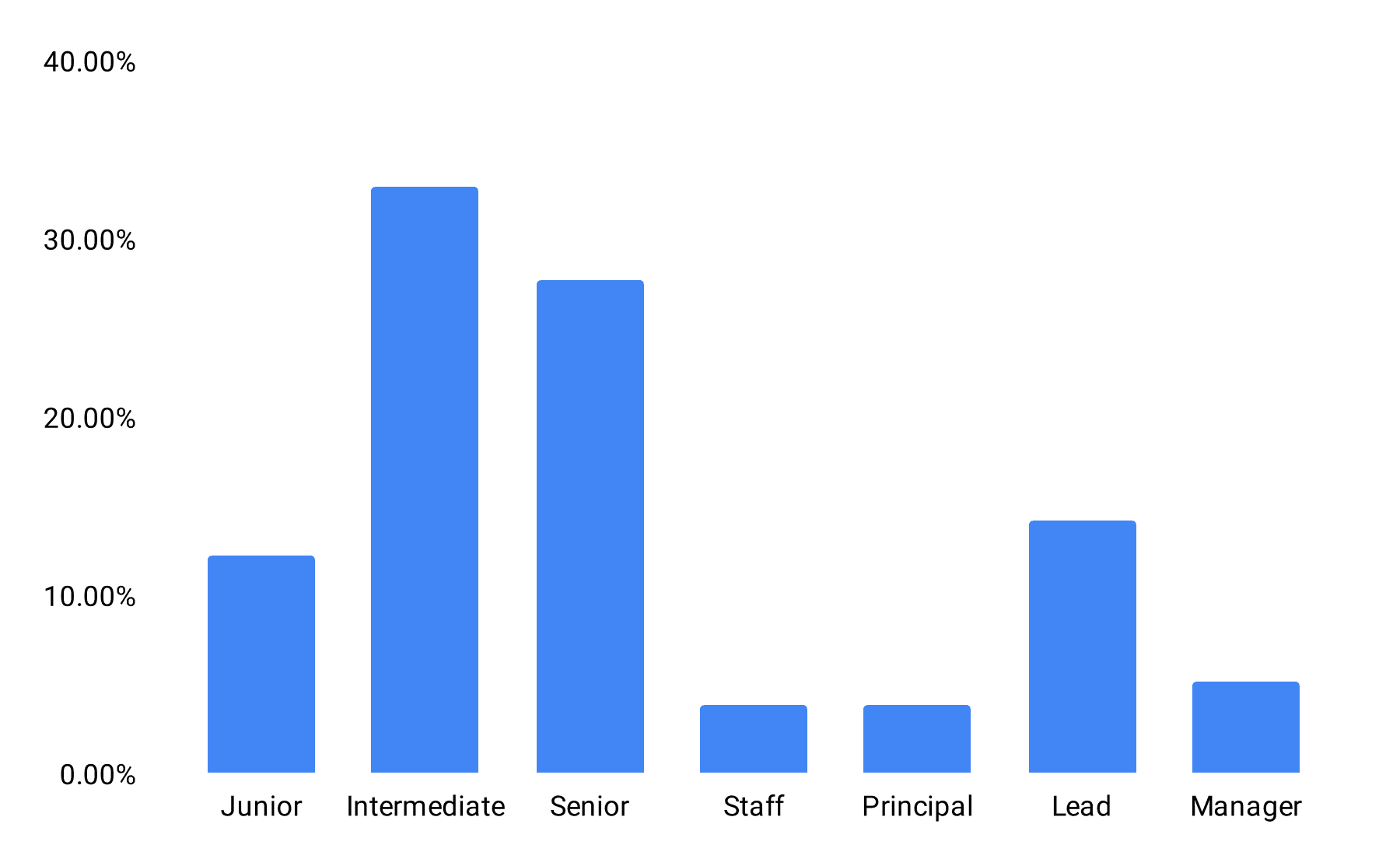
Here’s another thing that aligns with my thinking here—Staff, Lead, and Principal seniority levels together account for around 22 percent! The Manager role is often considered as equal to these Individual Contributor (IC) roles in a lot of companies. So if we add it to this group with its 5 percent, we’re already at 27 percent of all designers who responded being in the highest seniority roles! That’s equal to the Senior seniority and it competes for the second place. I work at a company where the seniority of designers in its UX department is very high so I kinda expected this, but I still find it surprising that the distribution is so skewed.

Why do designers quit their jobs?
Let’s get into the reasons why designers quit their jobs. There are two equal parts, both at around 19 percent: no career progression opportunities, and unhappiness with the work they do. Problems with company culture comes afterwards with almost 14 percent, and problems with a lack of UX maturity right after that with 11 percent. Almost 8 percent of designers left because their salary was too low, around 7 percent because of a poor relationship with their manager and another 7 percent because of misalignment with company values. Two surprises from the overall distribution: designers don’t have problems with a lack of speed anymore and they want the possibility to work remotely.

Years ago I remember quitting my design jobs because it would take ages for my designs to be implemented and released to get feedback. Other designers complained about it too. Now, only 1.5 percent chose this answer as their main reason for quitting. Interestingly, years ago it was never expected to be able to do a design job well remotely but now 3 percent of designers quit their jobs because they couldn’t work remotely! I expect this trend will continue.
Three reasons for quitting stand out:
- There was a lack of career progression opportunities
- The UX maturity of the company was low
- I wasn’t happy with the work I was producing and I couldn’t change that
But combing the data, slicing it by seniority and designer type, and analysing it shows the most interesting findings.
No career progression opportunities
Let’s take a closer look at one of the two most common reasons for designers quitting their jobs—no possibility for career progression. 18.5 percent chose this answer and I’m not surprised. It aligns well with the seniority distribution. As we saw, there are a lot of designers in lead positions, and an equal amount of them in senior roles (both at around 27 percent). There’s a ceiling for these designers because the higher you get on the ladder, the smaller the scales get. The higher designers get on the seniority ladder, the harder it is for them to get to the next step. There can be only one Head of Design at a company, for example.
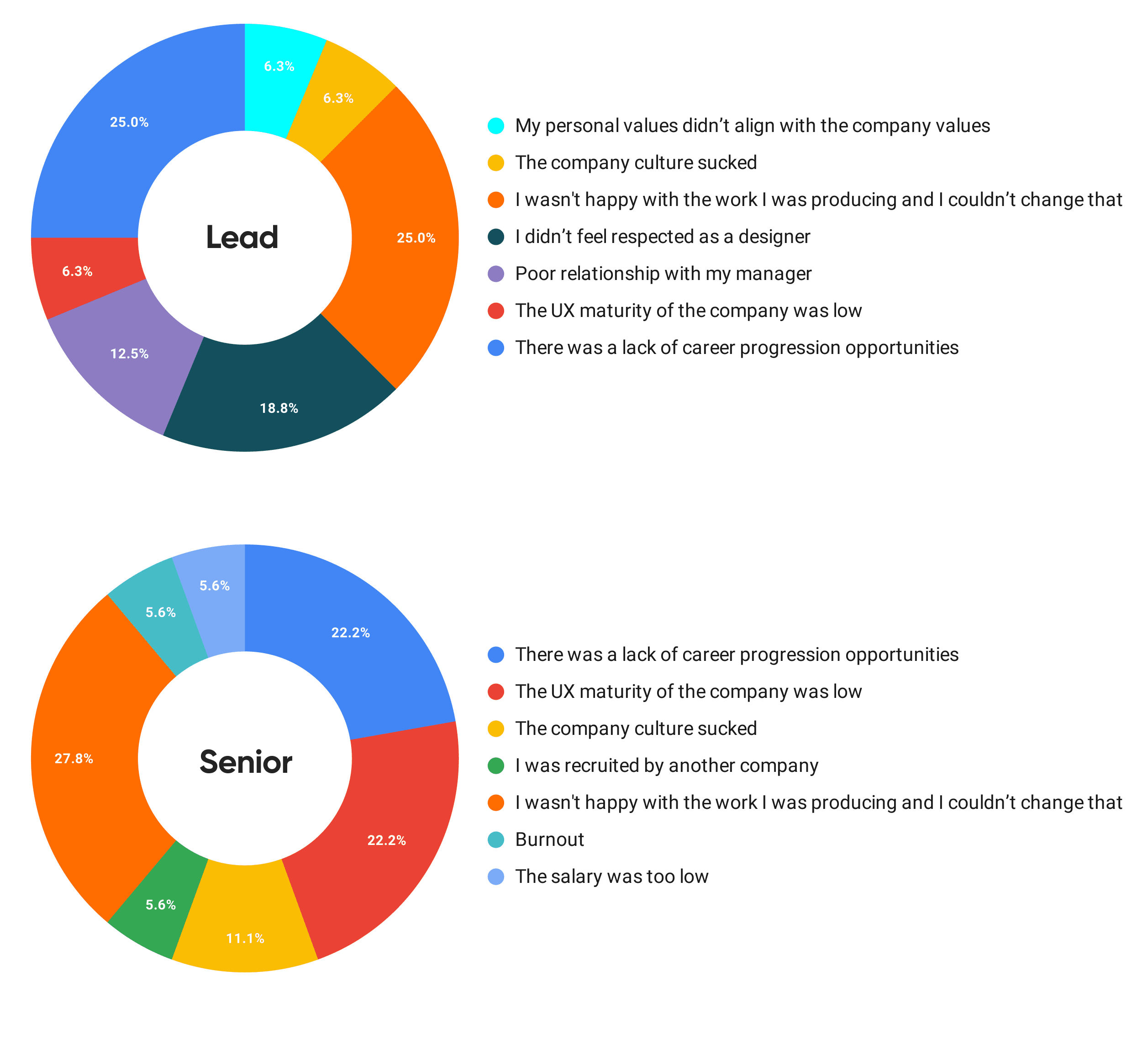
22 percent of senior designers picked this answer as their main reason, as well as 19 percent of designers in lead positions (Staff, Principal, Lead). For comparison, none of the junior designers, and only 10 percent of intermediate designers had this problem.
Problems with UX maturity
Problems with UX maturity continue to be an issue for designers. At least for those in junior, senior, and intermediate seniority level. 19, 20, and 25 percent respectively chose the answer “The UX maturity of the company was too low” as the main reason for quitting. I don’t find it surprising that out of these three, the junior roles are the least likely to quit because of it. When I was a junior designer I was happy to do any type of design work. But the more experienced I got, the more sophisticated design work I wanted to do. No surprises here.
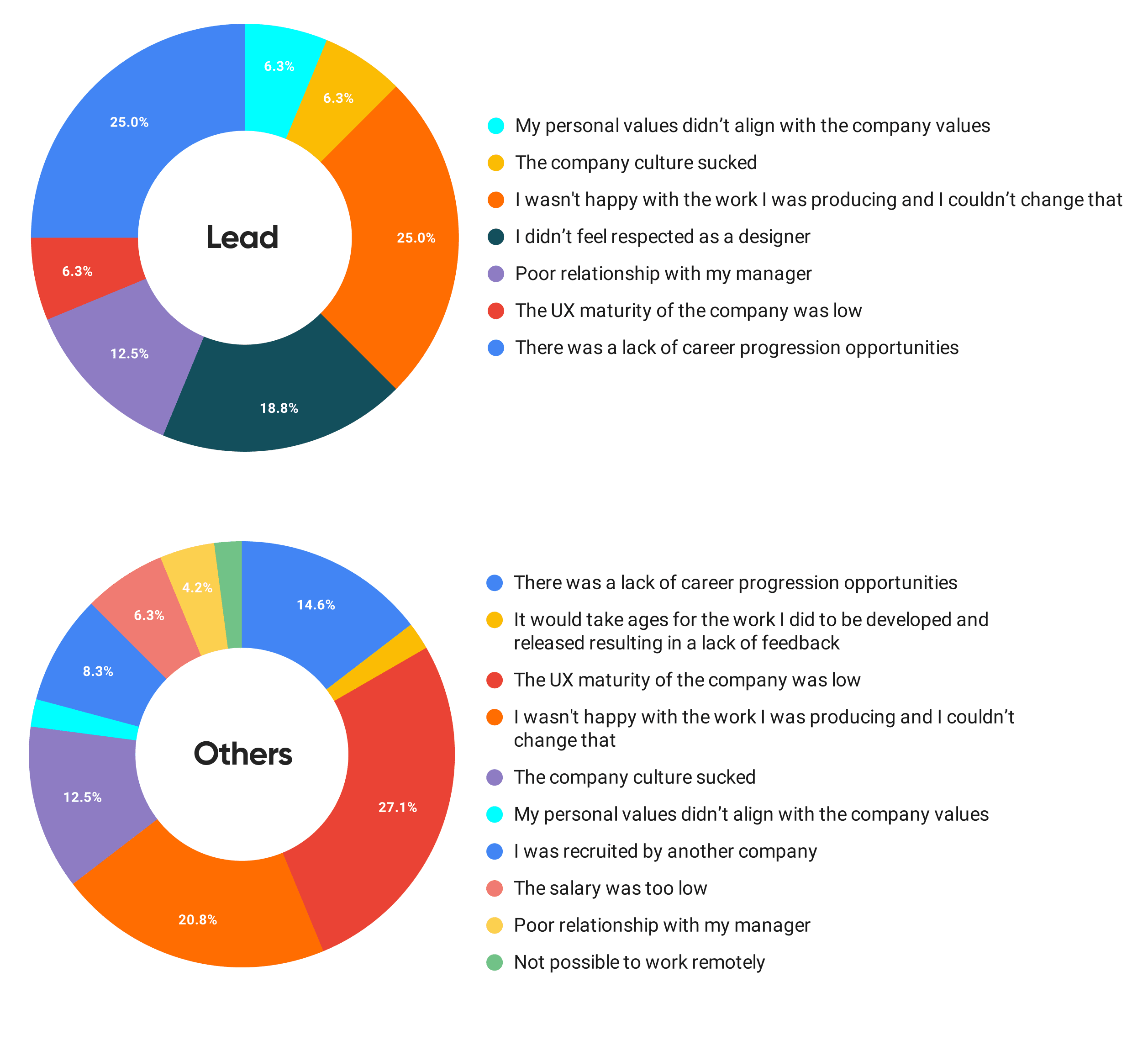
Here’s something interesting: only 5 percent of designers in lead roles (staff, principal, lead, manager) chose this answer. Is it because they have a positive impact on the UX maturity? Or does the presence of these higher seniority roles itself indicate that a company is more UX mature? There has to be a correlation here, I just don’t know what it is yet.
Unhappiness with the work they do
So the more senior the designers, the higher the UX maturity. But there’s another relation with high seniority of designers. The more senior they are, the less they are happy with the work they do. 24 percent of senior designers, 19 percent of lead designers, and 14 percent of intermediate ones chose the answer “I wasn’t happy with the work I was producing and I couldn’t change that” as their main answer for quitting their job. For comparison, only 10 percent of junior designers chose this answer. I don’t know yet how to interpret this information, but maybe it’s somehow connected to the previous problem from above? Is it because they’re stuck in their career, want to do more, want to have more responsibility but they can’t?
Design generalists are happier with the work they do
Design generalists stand out here. They’re mostly senior and lead designers when it comes to seniority (none of them in the study was junior). But unlike other designers of comparable seniority, they enjoy the work they do. Only 11 percent of them chose the “I wasn’t happy with the work I was producing and I couldn’t change that” answer, compared to 24 and 19 percent for senior and lead designers from above who aren’t generalists. Is it because they get to do a wider range of tasks, use more skills, and continue to learn more?
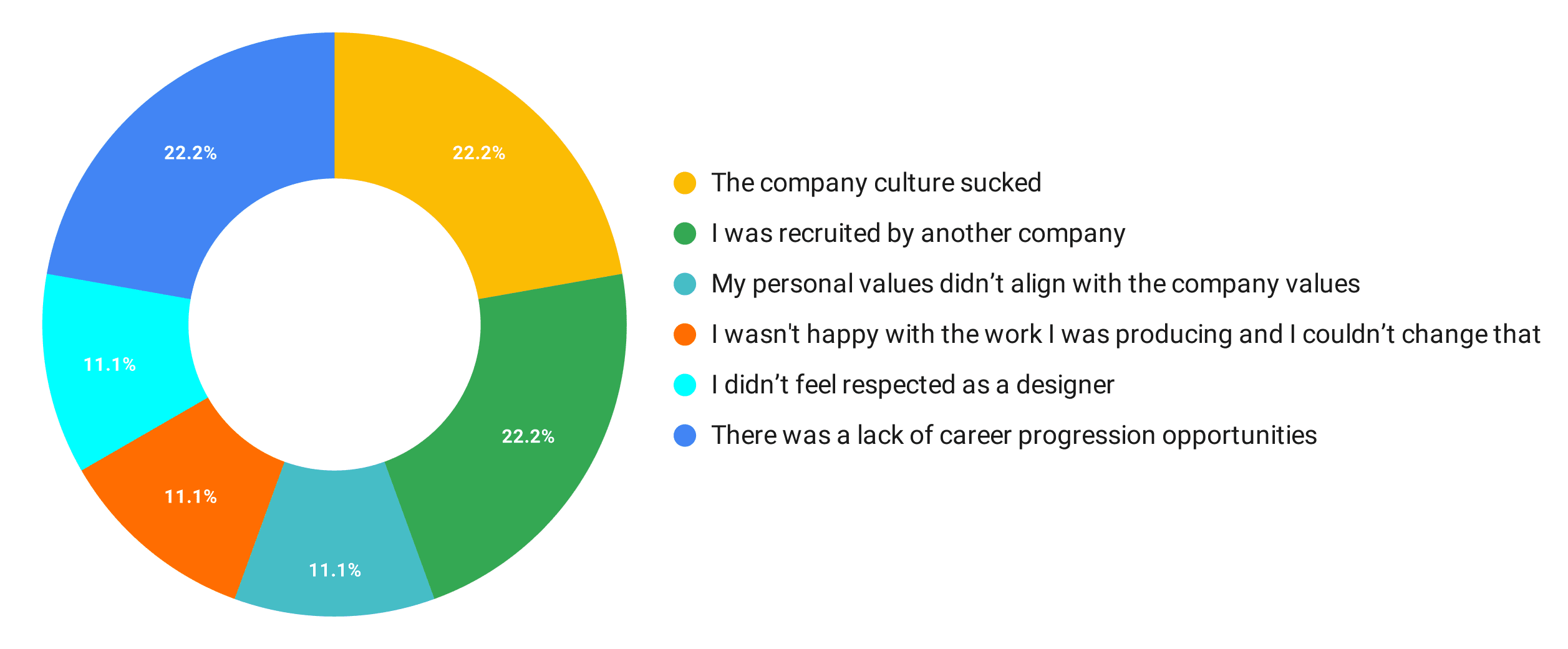
Another interesting thing about designer generalists is that that they get recruited more often. 22 percent of them chose the answer “I was recruited by another company” as their main reason for quitting, compared to 7 percent for intermediate, 5 for senior, and 10 for junior designers. It’s something that definitely sticks out and may be another thing indicative of the trend I mentioned in the beginning of this post. Are design generalists getting more desirable? I think that may be the case but let’s wait and see what the next years will bring.
Conclusion
This concludes my simple study, I think there are a few key findings to discuss. Does seniority of designers correlate with UX maturity of a company? If yes, how? Why are more senior designers less happy with the work they do? Is the UX industry as a whole becoming top-heavy? What will happen to all these senior designers who can’t get promoted? Let me know your thoughts bellow in the comments section 👇 As usual, one randomly picked commenter will receive a signed copy of my book Better Web Typography for a Better Web. I’ll pick the winner by the end of September and announce it here in the comments.
Another gentle nudge for my new course 😊 UX Buddy helps designers create their UX portfolio, find, and get an awesome UX design job. It’s now live and enrolment is open for a couple more days. Check it out!

Thanks for this. Unsolicited feedback: the pie charts would be easier to read if the slices and labels were ordered from most frequent to least. But nice post regardless!
Thanks Peter! I had a hard time making these charts as readable as possible. Considering they’re from Google Spreadsheets I think they turned out ok. I agree with you though. Will keep it in mind for next time 👍
Very interesting article, Matej!
As a junior UX designer, full of excitement about the industry, I’m just thankful about any opportunity given to me so that I can learn from it and shape my UX repertoire. That being said, I’m getting used to identify red flags in job descriptions in order to avoid joining a product team that will not offer any mentorship or interested in my career growth.
Thanks Aline! It’s great that you’re already careful with your career progression as a junior designer. All the best!
I thought maybe this could be discouraging for some, but I still didn’t get my first UX/UI job so… We’ll see! Great article btw.
Thanks Joanna, I’m glad you liked it! The first one is the hardest to get but once you do, all that follow will be much easier! Especially when you grow from junior, to intermediate, to senior!
One thought I have about the lower quantity of junior designers suggested by the ratio – with the topic of “why I quit”, we’re only counting junior designers who have both landed their first (non-freelancing) job, and then felt confident and secure enough to leave it. Looking at the proportions of junior to senior+ might be a bit different when including those in the initial job hunt, those who went straight into freelancing, and those who are either feeling content with or too scared to leave their first job.
This is a really good point Mary! 👆 Thanks for bringing it up!
Hey Mary, I randomly picked you to get a signed copy of my book, Better Web Type. Can you send me your address to [email protected]?
Thanks for taking time to conduct this research and report it! Very interesting to get a pulse on the design industry and why designers leave an organization. I’m curious if you were to add screening questions about the size of the organizations the participants worked at and if that coorelates with any of the answers.
That’s interesting Jonathan. 🤔 I’ll do that the next time I run the study!
This is such an interesting article which addresses a topic that personally has been on my mind for some time. Thank you for taking the time to conduct this research and dive into what really makes designers quit a job. Of course this is not an easy question to answer since there are many factors involved as you accurately mentioned in this article. However, this is a well-founded basis to open up the conversation on this matter. One of the points that I find the most interesting is the one about senior designers being less happy with the work they do. In my opinion, this comes down to the fact that the more you develop a trained eye, the higher your level of expectations about the work you produce are. In many cases, experienced designers rather go freelance hoping that they will get clients who would pay for the kind of work that they want to do. Others rather stay where they are since it’s more comfortable to get a paycheck at the end of the month. The truth is that this industry evolves constantly at a rapid pace and learning how to adapt to it without losing yourself in the process is what could potentially bring more satisfaction in whatever you’re doing to pay the bills. Last but not least, it would also be interesting to know more about what are the creative outlets that designers do to keep themselves motivated. How often do they work on side projects? What kind of hobbies do they have? What places do they travel to? Sometimes it’s hard to find the right job and this is usually out of our hands to some extent so it would be interesting to know more about the things that designers actually have more control of to keep themselves motivated.
I think you’re right Hernán! There must be a connection there. I use my side projects as that creative outlet, as well as my hobbies. It works out well enough for me 😊
Could you point me to a similar article for UX researcher…. would love to get some data
I’m sorry Gary but I don’t know if there is one.
Thanks for the article. Could you please tell us a bit more about the panel that answered to your study? For example, from which countries are the respondents?
Thanks
I didn’t ask that Amine, because I wanted the survey to be super short. It only had these three questions: job title, seniority, reason for quitting. But I’ll add more when I do it next time and I’ll add the country as well 👍
I think it’s an interesting question. I guess I might have stayed with my last pro job if I’d been able to work remotely. I was a human factors engineer/cognitive requirements analyst/interface/UX designer at a small cognitive science division of a large research and design company. The corporate culture sucked AND was not really what I’d been sold on when joining, which was more the small company culture that had existed there before they were acquired by the bigger corp. I mean, the culture on some of my project teams was fine, but the overall company ALSO pressured us all to pursue 15% growth across every aspect of the company – we were all supposed to be maintaining call lists and marketing some of the time despite not being trained for that, in a field where your previous performance and proposals are usually all the marketing you need.
But one of the biggest factors in my decision to leave doesn’t look like it’s represented in your selection of options for reason for leaving. A significant contributor to my departure was poor support for maternal leave and breastfeeding. I was pregnant when I quit, and had been told they had paid maternal leave when I was hired, but they did not – what they had was two weeks of HALF paid time off, IF you had signed up for their SHORT TERM DISABILITY at least ONE YEAR before getting pregnant, and then you had to take the two weeks off and then apply for the short term leave reimbursement –
you wouldn’t just get paid according to the usual pay cycle. Another coworker told me that she had not had her first pregnancy covered due to the same problem (getting pregnant under a year after being hired) – at which point it became really clear that someone should have known this was a less than stellar policy, but they also didn’t care.
In many other countries, maternal or parental leave is at least 4 to 6 weeks, and companies are required to provide a quiet private place at work to breastfeed or pump. We didn’t have that. My poor coworker was pumping breastmilk in her car on the way to and from work. And all of my projects up to that point had required a lot of travel. I just couldn’t imagine trying to breastfeed the baby for the first 6 months as recommended by the American Medical Association under such unsupportive conditions. It didn’t help that in my head I was contrasting that to the Menlo Software Factory culture, which was SO much better. I quit two weeks after having appendicitis while two months pregnant. Later that year I had a c-section and two months later my surgical wound re-opened, so it seemed just as well I wasn’t trying to work at the time. But I was still sad about the total disruption to my career.
Sorry to hear your story Anne. But thanks for sharing it. I think a lot of women out there can relate as conditions at work are mostly unaccommodating to this fundamental life change. I hope you find a better employer in the future when you’ll be ready to work again.
“This study offers some fascinating insights into why designers leave their jobs. It’s intriguing to see how UX/Product designers make up the majority of respondents. It would be interesting to dive deeper into the specifics of their challenges compared to other roles like graphic or web design. Looking forward to the breakdown you mentioned for the next study—this kind of data could be invaluable for improving work environments in the design industry!” https://micrositeshub.com/